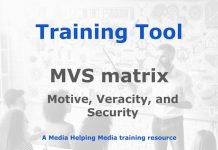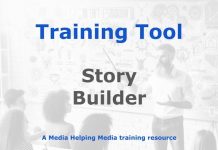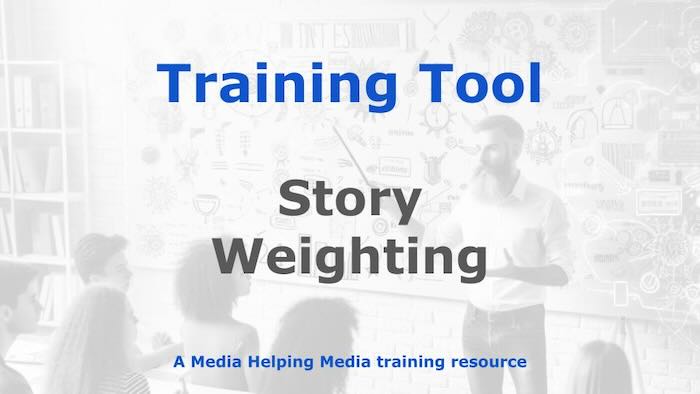 Different news stories have a different value for your audience and for your business. Giving news items a ‘weighting’ can lead to impact and efficiencies.
Different news stories have a different value for your audience and for your business. Giving news items a ‘weighting’ can lead to impact and efficiencies.
The Story Weighting System is a newsroom tool developed by Media Helping Media and used around the world for many years to help newsrooms focus their news production.
Some stories are fairly superficial without much depth. Such stories might be small, breaking news stories about a fire, an accident, or a new business development.
It might be possible to set out the main facts in a short piece with little or no in-depth analysis.
Other stories require investigation, further development, and a proactive approach to news gathering and news production.
This will often involve investing resources and effort to ensure the issue is explored fully.
So it doesn’t make sense to treat all stories equally. Which means that senior editors, news producers and reporters have to decide how much effort a story is worth.
This is where a story weighting system is invaluable. Let’s look at how it works.
Story weighting
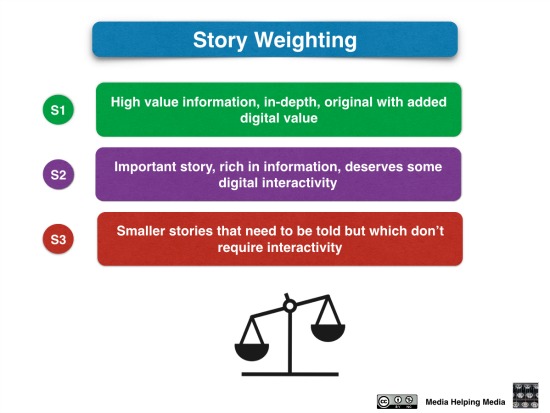
In the graphic above you will see three story types. For the sake of this module they are labelled S1, S2, and S3.
- An S1 story is one with high-value information, which involves in-depth reporting, is original, and has rich interactive digital assets (elements).
- An S2 story is an important story, rich in information, and which deserves some digital interactivity.
- An S3 story is a smaller story that needs to be told, but which doesn’t require interactivity.
You might decide there are other story types, but there is a benefit in keeping the system simple, which are explained below.
Benefits
Once a story has been given a weighting and a label, everyone in the news organisation knows what is required and what will be involved in producing the material.
- The editors won’t have to sit down with each producer and reporter in order to tell them what they want in terms of elements; the story weighting system will have already set that out.
- They won’t need to explain how long the piece is expected to be; the story weighting system will have already set out those parameters and expectations.
These parameters will have been set earlier as senior editors aim to cover the needs of the target audience, manage the newsroom resources that are available, priorities output, and ensure content is produced for all devices.
Once the story weighting rules have been set and circulated, all in the news process understand what is required.
- Such a system speeds up news planning.
- It improves the efficiency of news meetings.
- It helps editors brief reporters and producers because they already know what is expected.
And news delivery deadlines are clearer, and therefore more likely to be met.
Now let’s look at these story types in more depth.
The descriptions below are just there to illustrate the concept. These will change depending on how each news organisation chooses to define the story types. You might give the story types different names; that doesn’t matter.
What matters is that you create your own system aimed at maximum newsroom efficiency and productivity.
Note: This system works perfectly in a converged newsroom.
An S1 story type

An S1 story will probably be an exclusive, or a massive breaking/developing news story which is of importance to your audience.
Those who rely on you for reliable and accurate news coverage will be returning to their screens several times during the day for updates. They will be eager to know the latest developments.
Such a story will have an impact on their lives. Therefore, it makes sense for you to ensure that you allocate sufficient resources to the story in order that it is told properly.
For example, an S1 story might involve a lengthy package on TV with at least three clips of three different people making three different points.
It will probably involve lots of footage illustrating the issue being covered, perhaps a vox pop of people in the street.
There might be some graphics, and it could include a piece to camera (stand up), at the end.
In interactive terms, an S1 story might involve several related stories, video clips, a timeline, an infographic, a bullet-point fact file, interactive maps, a photo gallery, and, perhaps, a poll/vote.
It will certainly include social media engagement.
There will also be related stories and links to the archive for added context.
Producing this amount of material, and allocating sufficient resources to it, will mean that other, less important stories that are also on the news agenda will have to be treated differently or dropped.
Based on the above, the editors defining your story weighting system will add timing for all the above helping the producers and reporters understand when the material will be required.
And that is where story weighting is valuable. The editor in charge of the day’s output gives each story a weighting so that everyone knows what is required and what is the priority.
An S2 story type

This story type is also important, but perhaps not the lead or second lead story. It will be a story that demands fewer resources and less effort than the S1 story type.
For example, an S2 story type might have a shorter package for TV, with perhaps two clips putting different sides of the story, it will involve some footage from the scene of the event being covered, it might require a graphic, there will probably be a piece to camera at some point in the package.
In interactive terms it will probably be a 300-500 word read with some video clips and an infographic. There will be some social media response added in order to engage the audience. There might be one or two related stories.
It will take less time and effort to produce than an S1 and, therefore, the journalist producing it will be working to a shorter timetable.
An S3 story type

This story type will be a general news piece that requires little effort. It will be a straightforward breaking or developing news item.
For TV, it will probably be a voice-over script, perhaps with a piece to camera at the end. In interactive terms, it’s probably a straight 300-word read with an image or graphic.
An S3 story shouldn’t take too long to produce.
Applying story weighting
Now we have the story types, we can see how the editor-of-the-day can produce an overview of the main stories to be covered.
Below is a fictitious list of stories that might be considered for a TV bulletin, with the story weighting coding set out on the right.
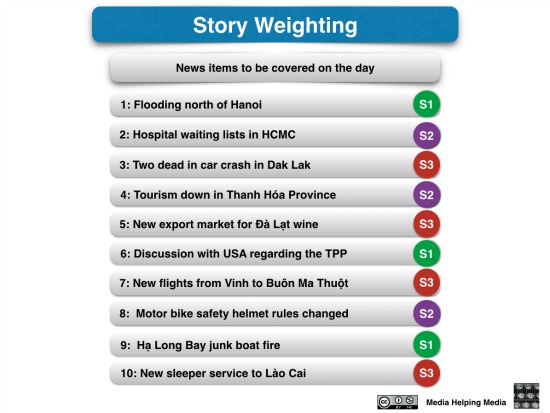
This system means that everyone attending the news meeting, or checking on the news prospects during the day, is able to see exactly what is required, the resources to be allocated, and the time it should take to produce the material.
The story weighting system also prioritises effort on the stories that are of most value to the target audience.
This, in turn, makes the management of news far more systematic and focused on business priorities, which, in turn, leads to greater efficiency, a saving in costs, a stronger editorial proposition, and more informed and motivated staff.
Key benefits:
- Improved efficiency:
- Speeds up news planning and meetings.
- Streamlines the briefing process for reporters and producers.
- Optimises resource allocation based on story importance.
- Helps meet news delivery deadlines consistently.
- Enhanced clarity and communication:
- Establishes clear expectations for all staff regarding story requirements.
- Eliminates ambiguity about story length, content, and digital elements.
- Ensures everyone understands story priorities.
- Strategic resource management:
- Prioritises high-value stories, ensuring they receive adequate resources.
- Allows for the efficient management of newsroom resources.
- Facilitates informed decisions about which stories to pursue or drop.
- Increased productivity:
- Reduces time spent on repetitive explanations and discussions.
- Creates a systematic and focused approach to news production.
- Creates a more motivated staff.
- Improved content quality:
- Focuses effort on stories that are most valuable to the target audience.
- Ensures in-depth reporting and rich digital content for high-priority stories.
- Strengthens the editorial proposition.
- Cost savings:
- By increasing efficiency, the system saves on resource and labour costs.
- In essence:
- Work smarter, not harder.
- Deliver higher-quality content.
- Maximise impact with limited resources.
- Maintain a better organised newsroom.
Content value matrix
You might want to use the story weighting tool in conjunction with another method developed by Media Helping Media – the content value matrix. Below is a slide prepared for a training course in Harare for the former Mobile Community Zimbabwe.
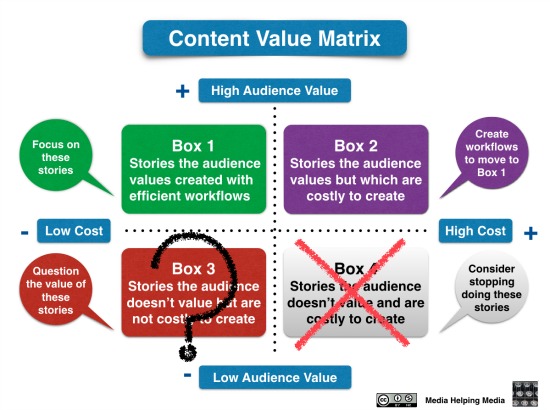
Related article





